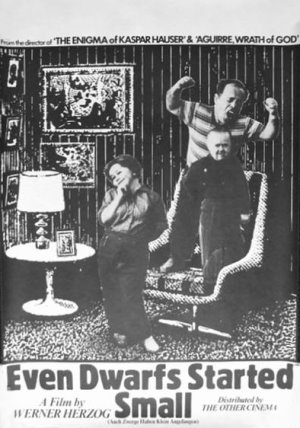
EVEN DWARFS STARTED SMALL
West Germany, 1970, 96 Minutes, Colour.
Helmut Doring, Gerd Gickel, Paul Glauer, Erna Gschwnedter.
Directed by Werner Herzog.
Even Dwarfs Started Small is one of the earliest features of celebrated German director, Werner Herzog. During the 70s Herzog established quite a reputation for himself with his individual view of life and the striking quality of his films, e.g. Aguirre, The Wrath of God, The Enigma of Kasper Hauser, various films with Bruno S and Klaus Kinski and the commercial reworking of Murnau's Nosferatu. This is more modest in its technical side although ambitious in its scope. The film is a difficult allegory of 20th century society - a satiric view of life along the lines of Jonathan Swift mixed with Franz . The setting is an asylum; it is peopled by dwarfs. There is a revolution. The revolution is necessary - but the behaviour of the revolutionaries seems to be little better. The final image is of the leader of the revolution laughing. Within this frame work of black humour, philosophical and symbolic language as well as improvised acting, many symbolic actions take place. The viewer is asked to respond to the images, and, if possible, link them. This makes for an avant garde type film and makes demands on its audience. It is not particularly appealing - definitely a film for study.
1. The work of Werner Herzog - his early and experimental work? His view of life? His technical ability with cinema and images? His impact on the German industry and on world viewing?
2. The black and white photography, the Spanish settings, the hacienda? The use of interiors and exteriors? The yards of the Hacienda? An enclosed world - asylum, prison? The ironies of the use of nature, of machines, eg. the car? A microcosm of contemporary society?
3. The variety of music, songs? Their contribution to atmosphere, meaning?
4. What kind of world was this enclosed world of the hacienda? The conventions of fable and allegory for inviting the audience into this world, understand its code and laws? What kind of society, authority, revolution, anarchy? Authoritarianism and its being supplanted and going insane? Oppressed minorities being victims, revolutionaries, unable to put order into their own lives with their newly gained freedom?
5. The significance of having dwarfs - audience response to dwarfs and their appearance, small people, potential victims, a minority? The limitations of the dwarf in dealing with society of fully sized people? The black humour at the expense of dwarfs, through the dwarfs? A symbol of dwarfed society? Appearances, sounds? Dwarfs and their behaviour parallelling ordinary sized people? The focus on the anomalies?
6. The symbols in the detail of chaotic behaviour? The laughing, anger? The symbol of the fowl cannibalising? The fowl? The barbaric overtones of the behaviour?
7. The anarchical behaviour: the cutting the telephone wires, the aimless revelling, haranguing the deputy, pulling down the palm tree, the small rebels making love on the instructor's bid, the nudes in the magazine, tormenting the blind inmates, the threats to burn the place, the killing of the sow, the smashing of the crockery and the furniture, the hurling of the food, burning the potted plants, the mock religious procession, the monkey tied to the crucifix, the deputy and the live chickens and the broken windows? The camel brought to its knees? The cumulative effect-of these images?
8. The character of the deputy - his being imprisoned, haranguing, going mad? The contrast with Pepe and his being tied up, his laughing - and the long camera hold on his laugh at the end?
9. The opening and the number? The ending and the camel? An experience of allegorical mockery? The delineation of the characters? The vivid impact of the action? The importance of sense, emotional and intellectual response to this kind of allegory? The opening and the number? The ending and the camel? An experience of allegorical mockery? The delineation of the characters? The vivid impact of the action? The importance of sense, emotional and intellectual response to this kind of allegory?